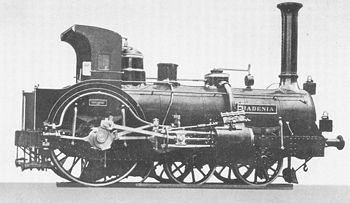Baden IX (old)
| IX IIa old (from 1868) |
||||
|---|---|---|---|---|
| ADLER and FALKE | COMET to BASEL | RHEINFELDEN to PALATINATE | BADENIA to OFFENBURG | |
| number | 2 | 8th | 8th | 8th |
| Manufacturer | Mechanical Engineering Society Karlsruhe | |||
| Construction year | 1854 | 1854-1856 | 1858-1859 | 1863 |
| Retirement | 1875-1903 | |||
| Axis formula | 2A n2 | 2'A n2 | 2A n2 | |
| Gauge | 1,435 mm | |||
| Length over buffers | 13,030 mm | 13,150 mm | 13,110 mm | 12,580 mm |
| height | 4,584 mm 4,550 mm (after conversion) |
4,500 mm | 4,410 mm | |
| Total wheelbase | 3,750 mm | 4,380 mm | 3,750 mm | |
| Empty mass | 25.90 t | 26.35 t | 24.00 t | 24.25 t |
| Service mass | 27.90 t | 28.50 t | 27.70 t | 28.00 t |
| Friction mass | 11.5 t - 13.0 t | |||
| Wheel set mass | 13.0 t | |||
| Driving wheel diameter | 2,134 mm | |||
| Impeller diameter | 1,374 mm (1st axis) 1,220 mm (2nd axis) |
1,220 mm | ||
| Control type | Gooch | Stephenson | ||
| Number of cylinders | 2 | |||
| Cylinder diameter | 405 mm | |||
| Piston stroke | 560 mm | |||
| boiler | Pear kettle | Crampton | ||
| Boiler overpressure | 7.0 bar | 8.0 bar | ||
| Number of heating pipes | 215 | 205 | 209 | |
| Heating pipe length | 3,085 mm | 3,095 mm | ||
| Grate surface | 1.07 m² | 0.98 m² | 0.92 m² | |
| Radiant heating surface | 6.74 m² | 5.83 m² | 5.62 m² | |
| Tubular heating surface | 76.06 m² | 72.52 m² | 74.17 m² | |
| Evaporation heating surface | 82.80 m² | 78.35 m² | 79.79 m² | |
| Locomotive brake | Screw brake on the tender | |||
| tender | Kessler 3 T 5.4 | |||
The steam locomotives of class IX , from 1868 class II a old of the Grand Ducal Baden State Railroad, were Crampton locomotives .
history
The locomotives were originally designed for the 1,600 mm wide gauge , but were made for this gauge because the route network had been switched to standard gauge . The vehicles were as pure freight train - machines planned by the change to standard gauge, the draft was changed to an express locomotive.
Due to the almost ten-year construction period, design changes and experiments were made in order to achieve the best possible result.
The first two ADLER and FALKE locomotives were given a returning flame tube (chimney in the middle of the boiler) but were converted to a normal smoke chamber before they were finally taken over by the State Railways . In the second delivery series COMET to BASEL , a bogie was used instead of two running axles. The BASEL was at the 1885 World's Fair presented in Paris. With a train of 67 t, the locomotive reached a speed of 64 km / h.
When the friction mass of around 12 t was no longer sufficient for the increasingly heavy express trains, the locomotives were transferred to passenger train service and later to shunting service.
The locomotives were equipped with external frames, external cylinders and Hall eccentric cranks. They possessed all the characteristics of a Crampton locomotive as the single, behind the firebox lying driving axle with wheels of large diameter or deep boiler location. Initially, the driver's cab was open and only surrounded by a railing, only later was the locomotive personnel better protected by the construction of a simple driver's cab with narrow side walls.
Preserved copy of the series
The PHOENIX series locomotive, built in 1863, was used as a shunting locomotive at Mannheim station until the 1890s . The locomotive was badly damaged during the Second World War. In 1960 it was refurbished in the Munich-Freimann repair shop and is now on display in the Nuremberg Transport Museum.
literature
- Hermann Lohr, Georg Thielmann: Baden locomotive archive . transpress, Berlin 1988, ISBN 3344002104
Web links
Individual evidence
- ↑ To distinguish the locomotives designated according to the 1868 scheme, also designated as IX (old) .




